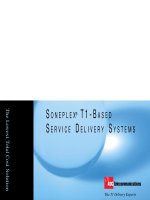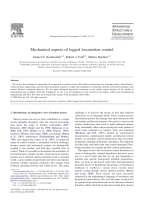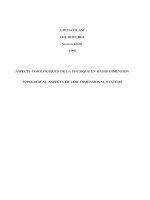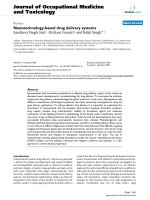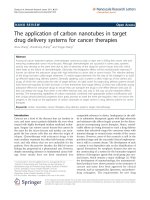Chemical Aspects of Drug Delivery Systems pptx
Bạn đang xem bản rút gọn của tài liệu. Xem và tải ngay bản đầy đủ của tài liệu tại đây (15.25 MB, 174 trang )
Chemical Aspects
of
Drug
Delivery Systems Chemical Aspects
of
Drug
Delivery Systems
Edited
by
D.
R.
Karsa
Akcros Chemicals
UK
Ltd., Manchester
R.
A.
Stephenson
Chemical Consultant
THE ROYAL
SOCIETY
OF
CH
EM
I
STRY
Information
Services
The proceedings
of
a Symposium organized by the Waterborne Polymers Group
of
The British Association
for
Chemical Specialities (BACS)
and
the MACRO Group UK
(Joint Group of The Royal Society
of
Chemistry and the Society
of
Chemical Industry)
at Salford University on 17-1
8
April 1996.
Special Publication
No.
178
ISBN 0-85404-706-9
A
catalogue record for this book is available from the British Library.
0
The Royal Society of Chemistry 1996
All
rights reserved.
Apart from any fair dealing for the purposes of research or private study, or criticism or review as
permitted under the terms of the
UK
Copyright, Designs and Patents Act,
1988,
this publication may
not be reproduced, stored or transmitted, in any form or by any means, without the prior permission
in writing of The Royal Society of Chemistry, or in the case of reprographic reproduction only in
accordance with the terms of the licences issued by the Copyright Licensing Agency in the
UK,
or in
accordance with the terms of the licences issued by the appropriate Reproduction Rights Organization
outside the
UK.
Enquiries concerning reproduction outside the terms stated here should be sent to
The Royal Society of Chemistry at the address printed on this page.
Published by The Royal Society of Chemistry,
Thomas Graham House, Science Park, Milton Road,
Cambridge CB4 4WF, UK
Printed by Bookcraft (Bath) Ltd
Introduction
Despite the advances in the development of new drugs, a drug may never reach the
target organ, or it may be difficult to achieve the necessary level
of
drug in the
body. Large doses can result in serious side effects, and can harm normal cells and
organs as well as diseased cells. Hence controlled release and the targeting of deli-
very systems must evolve in parallel to drug research.
This symposium, jointly organized by the Waterborne Polymers Group of BACS
(The British Association for Chemical Specialities) and Macro Group
UK
(the joint
Group of the Royal Society of Chemistry and the Society
of
Chemical Industry),
covers some
of
the advances in the Chemical Aspects of Drug Delivery Systems.
New materials for drug delivery and targeting are reviewed and a representative
range of excipients and delivery systems is considered in depth. Particular attention
is given to poly(ethy1ene oxides) and derivatives, carbohydrate derivatives (includ-
ing starch, lactose and microcrystalline cellulose) and selected water-soluble poly-
mers and hydrogels.
Although
a
single volume can never cover all aspects of
so
broad a topic, the
editors hope that this volume will serve as a useful introduction to chemists and
pharmacists new to this field of research and a valuable addition to those who are
already familiar with this subject.
R.
A.
Stephenson
D. Karsa
New Materials and Systems for Drug Delivery and
Targeting
P. York
1
The Use of Bioadhesive Polymers as a Means of Improving
Slobodanka Tamburic and Duncan
Q.M.
Craig
Drug Delivery
11
Some Novel Aspects of Transdermal Drug Delivery
Kenneth
A.
Walters
41
'
Controlled Drug Release Using Hydrogels Based on
Poly(ethy1ene glycols): Macrogels and Microgels
Neil
B.
Graham and Jianwen Ma0
52
Structural Investigations of the Monolayers and Vesicular
Bilayers Formed by a Novel Class
of
Nonionic Surfactant
M.J.
Lawrence,
S.
Chauhan,
S.M.
Lawrence,
G.
Ma,
J.
Penfold, J.R.P. Webster and D.J. Barlow
65
Non-ionic Surfactant Vesicles and Colloidal Targeting
Graham Buckton
Delivery Systems: The Role of Surfactant Conformation
77
Monofunctional Poly(ethy1ene glycol): Characterisation
and Purity for Protein-Modification Applications
M.
Roberts and D.F. Scholes
89
Lactose
-
The Influence of Particle Size and Structure
H.
J.
Clyne
on Drug Delivery 97
Chemical Aspects
of
Drug Delivery Systems
Vlll
Functional Differences and Regulatory Aspects of Lactose
Products Labelled as Lactose Modified
Jan
J.
Dijksterhuis
Flexibility in Tablet Formulation by Use of Lactose
Based Direct Compression Compounds
Klaus Peter Aufmuth
Compressional and Tableting Performance
of
High Density
Grades of Microcrystalline Cellulose
G.E. Reier and T.A. Wheatley
Starch Based Drug Delivery Systems
J.P.
Remon,
J.
Voorspoels,
M.
Radeloff and R.H.F. Beck
Trehalose and Novel Hydrophobic Sugar Glasses in Drug
Stabilization and Delivery
E.M.
Gribbon, R.H.M. Hatley,
T.
Gard,
J.
Blair,
J.
Kampinga and B.J. Roser
Aqueous Shellac Solutions for Controlled Release Coatings
Manfred Penning
Information Requirements for Drug Delivery Systems
Kassy Hicks
Subject Index
105
112
116
127
138
146
155
157
New Materials and Systems for Drug Delivery and
Targeting
P.
York
POSTGRADUATE STUDIES IN PHARMACEUTICAL TECHNOLOGY, SCHOOL OF PHARMACY,
UNIVERSITY
OF
BRADFORD, BRADFORD BD7 IDP, UK
1
INTRODUCTION
The range of bioactive substances emerging as potential drug candidates, together with
those currently under research and development, continue to provide major challenges
for efficient drug delivery and targeting. Various strategies for formulation design using
diverse chemicals as formulation excipients are available, and numerous materials
are
being considered and developed to provide specific fbnctionalities
in
the design of
medicines.
A
number of approaches to formulation and drug delivery will be discussed
at this symposium and this lecture, serving as a general introduction, highlights the need
and value of these approaches coupled with the related issues of excipient properties and
design.
It has been a constant ambition of formulation scientists to optimise drug delivery
systems which provide a defined dose, at a chosen rate, at a selected time, to a targeted
biological site. Whilst improvements
in
drug delivery over recent years are impressive,
there is still some way to go in
filly
achieving these objectives. Key issues requiring
continuing research and study range from fbndamental understanding of the biosystems
and targets and basic characterisation of novel classes of bioactive agents, to the
development of ‘designer’ or ‘smart’ materials which provide required excipient or
carrier properties to achieve modulated and targeted drug delivery. Coupled with these
activities is the necessary realism of the practical constraints imposed
in
designing drug
delivery systems. These include the necessity of using materials which will achieve
regulatory approval and clearance, and the constraints imposed by the nature of the
various routes of administration available for drug delivery.
2
ROUTES
OF
ADMINISTRATION
AND
CLASSIFICATION OF DRUG
DELIVERY SYSTEMS
The principal routes of administration for medicinal products are listed
in
Table
1,
together with a general classification of the main groups of traditional dosage forms.
The choice of an appropriate route of administration for a specific bioactive will be
influenced by many factors, such as required time
of
onset of action or drug targeting
issues.
Similarly, selection of drug delivery class
is
based on these and other numerous
factors, as well as features related to the properties of the bioactive material itself, such
as solubility and stability.
2
Chemical Aspects
of
Drug Delivery Systems
Table
1
Routes of administration and general classification of drug delivery systems
ROUTES
OF
ADMINISTRATION
ORAL
PULMONARY
TOPICAL
BODY CAVITY
(e.g. nasal, eye, buccal)
PARENTERAL
(e.g. i/v,
Urn,
s/c)
DRUG DELIVERY
CLASS
SOLIDS
(e.g. tablets, capsules)
(e.g. gels, creams)
SEMI-SOLIDS
LIQUIDS
-
SOLUTIONS
COLLOIDS
EMULSIONS
The explosion of synthetic and semi-synthetic bioactive substances in the
1950’s
and
1960’s,
which continues to the present day, led to the development of a range of the
conventional dosage forms which dominate the range
of
medicines available today.
However, newer trends and strategies in drug discovery with the advent of highly potent
compounds or those requiring location at specific biological tissues or sites has led to
the development
of alternative drug delivery systems, which attempt to address the
requirements
of
rate and extent of drug release, and thereby absorption. Delivery
systems include oral sustained release formulations’ (e.g. multiple unit disintegrating
particles or beads, single unit non-disintegrating system), controlled release preparations
(e.g. oral osmotic pump2) and bioadhesives3 and liposomes4. The products of
biotechnology research
in
the
1980’s
and
1990’s
have imposed even greater demands on
drug delivery formulations and drug targeting with the emergence of peptides, problems,
oligonucleotides and elements
of
DNA as potential drug candidates, since specific
challenging features of such bioactives in terms
of
efficient and safe drug delivery need
to be addressed from the points of view
of
administration route and suitable excipient
and carrier materials.
Table
2
highlights the various groups of chemicals that are used as vehicles, carriers
and excipients
in
both conventional and more recent approaches to formulating
medicines. Much research activity is focused on the development and testing of new
carrier systems, such as biodegradable polymers, such as the polylactides, and composite
materials like low density lipoproteins.
3
DRUG DELIVERY
AND
TARGETING
A diagramatic illustration
of
the inter-relationship between the components controlling
the processes
of
drug delivery and targeting is presented
in
Figure
1.
In
the diagram, the
New Materials and Systems for Drug Delivery and Targeting
Table
2
Range of chemical groups used as vehicles, carriers and functional excipients
in
drug delivery systems
3
CHEMICAL GROUP
INORGANICS
CARBOHYDRATES
SURFACTANTS
POLYMERS
LIPIDS, FATS
AMINO-ACIDS,
PEPTIDES,
PROTEINS
EXAMPLES
-
CALCIUM PHOSPHATE
-
TITANIUM DIOXIDE
-
a
-
LACTOSE
MONOHYDRATE
-
j3
-
CYCLODEXTRIN
-
SODIUM LAURYL
SULPHATE
-
POLOXAMERS
-
STARCH
-
ETHYL CELLULOSE
-
HYDROGELS
-
POLYACRYLIC ACIDS
-
POLYLACTIDES
-
STEARIC ACID
-
GLYCERIDES
-
PHOSPHOLIPIDS
-
LEUCINE
-
LOW DENSITY
LIPOPROTEIN
-
diluent for solid dosage forms
-
opacifjing agent
-
direct compression tableting
-
drug complexing agent
excipient
-
promote drug particle wetting
-
targeting of colloidal particles
-
tablet disintegrant
-
film
former for coating solid
-
matrix for controlled drug
-
bioadhesive polymers
dosage forms
release
-
biodegradable polymer
-
tablet lubricant
-
matrix for controlled drug
-
formation of liposomes
release
-
tablet lubricant
-
microparticulate drug carrier
system
drug is delivered via a carrier system and four situations are identified.
In
A,
leakage of
the drug occurs as the drug-carrier system moves down the route of administration,
whilst
in
B
the drug is lost via the walls of the delivery route to non-target sites.
In
C
and
D,
successfbl drug delivery to the target sites is achieved although drug loss to
surrounding tissues can occur. Carefbl attention must thus be given to the
characteristics of the targets, including access and location, as well as the characteristics
of any carrier materials incorporated into drug delivery systems.
4
DRUG LEAKAGE+ +NON TARGET
+METABOLISM
/CLEARANCE
IB
I
DRUG
+
CARRIER
IDRUG
+
CARRIER
I
IDRUG
+
CARRIER
I
ROUTE
OF
ADMINISTRATION
+NON TARGET
+METABOLISM
/CLEARANCE
ITARGET
1
+METABOLISM
/CLEARANCE
+
-1
+METABOLISM
/CLEARANCE
Ic
P
Figure
1
carrier and target (adapted
from
Florence4)
Components
for
drug delivery and targeting
-
route
of
administration,
4
CARRIER
SYSTEMS
In many cases, carrier materials are used
in
particulate forms, and Table
3
lists
various types
of
microparticle colloidal carrier systems, together with ranges of particle
diameters in nanometers. Microspheres and nanoparticles have continuous matrices
containing dispersed or dissolved drug whilst microcapsules and nanocapsules are
composed of a drug core surrounded by a layer acting as a coating or barrier to drug
difision or dissolution. Vesicles are made up of single or multi-lamellar bilayer
spherical particles containing drug within their lipid or aqueous regions. Emulsion and
microemulsions are composed
of
oil or aqueous droplets dispersed in a continuous
phase of the other liquid, or multiple emulsions (ie, oil-in-water-in-oil and water-in-oil-
in-water5), with drug dissolved
in
either or both oil and aqueous phases. Low-density
lipoproteins have the benefit of being natural materials and drug can, for example, be
adsorbed onto the protein or phospholipid head groups, solubilised in the lipid
containing core, or attached to the surface. The range in particle sizes available for the
various carrier systems provides potential regarding choice of administration route
allowing smaller particles to be administered by parenteral routes for intravenous,
subcutaneous and intramuscular drug delivery.
The types
of
carrier materials used, the drug substance and the biological
environment for drug delivery all influence the mechanisms of drug release. Table
4
highlights the principal release mechanisms and drug, particle and environmental factors
influencing drug release. The complex matrix of variables and interactions which
influence and ultimately control drug release will clearly continue to provide major
challenges for pharmaceutical scientists working
in
drug delivery and targeting.
New Materials
and
Systems for Drug Delivery and Targeting
Table
3
Microparticulate colloidal carrier systems*
5
SYSTEM
MICROCAPSULES
EMULSIONS
MICROSPHERES
MULTI-LAMELLAR VESICLES
NANOCAPSULES
UNI-LAMELLAR VESICLES
NANOPARTICLES
MICROEMULSIONS
LOW-DENSITY LIPOPROTEINS
SIZE
(nanometers)
1000-
100,000
200
-
30,000
200
-
30,000
200
-
3,500
50
-
200
25
-
200
25
-
200
20
-
50
20
-
25
(*adapted fiom Florence4)
5
FORMULATION STRATEGIES FOR CONTROLLED DRUG RELEASE
AND
DRUG TARGETING
A variety of approaches to formulation design are available and are being developed,
some of which incorporate the newer excipients and materials with specific and directed
fbnctionality in terms of drug release. Tables
5A
and
5B
list a number
of
formulation
systems used by the oral, parenteral and pulmonary routes.
Strategies range fiom
chemical modification of the drug substance to provide a lower solubility salt, to more
complex drug delivery systems involving enzymatic breakdown of a formulation
component or particle coating to effect drug release', to the delivery
of
drugs containing
liposomes to the lungs by nebulisation'.
Recent developments have hrther extended opportunities with the advent of
externally activated drug delivery systems (see Table
6).
Activating sources based on
heat, sound, light, electrical pulses and magnetic fields are coupled with advanced
materials incorporated into dosage forms to achieve controlled, pulsed and/or modulated
drug release. Whilst many
of
these systems are in their infancy the potential
of
these
approaches will continue to be explored, undoubtedly leading to advanced drug delivery
systems.
6
Table
4
Mechanisms and properties
systems*
MECHANISM OF DRUG
RELEASE
DIFFUSION
EROSION
PARTICLE DISINTEGRATION
CHARGE EFFECTS
MEMBRANE
PERMEABILITY
CONTROL
Chemical Aspects
of
Drug
Delivery Systems
influencing drug release
from
particle carrier
PROPERTIES
INFLUENC~NG
DRUG
RELEASE
DRUG
-
concentration,
particulate location
and distribution
-
molecular weight;
physicochemical
properties
-
drug:carrier
interactions
PARTICLE
-
type, amount
adjuvants, matrix
-
size, density,
surface
properties
BIOLOGICAL
-
pH, polarity, ionic
FLUID/
strength
ENVIRONMENT
-
surface tension,
viscosity
-
temperature
-
enzyme
~ ~~~
(*adapted from Tomlinson6)
6
DRUG PARTICLE ENGINEERING
Drug particle engineering, or crystal engineering, provides an additional dimension
to drug delivery and targeting. Traditional methods of particle formation, crystallisation
and precipitation from solvents, do not generally provide the preferred properties
required for formulation and processing of drugs into drug delivery systems, and it is
common for additional processing to be carried out, such as milling and classification.
However whilst such extra processing provides desired characteristics (eg, particle size
and size distributions), changes
in
other properties can take place in an uncontrolled
manner leading to batch inconsistency and thereby lack of precise control
of
performance
in
formulated products.' Physicochemical changes observed include solid
state phase transitions and surface crystallisation. In this respect the non-equivalency of
particles resulting from conventional crystallisation, harvesting and drying operation can
be added to by fbrther processing. Understanding of these changes has been facilitated
by recent developments in high resolution analytical techniques, such as
microcalorimetry" inverse phase gas chromatography" and x-ray powder diffraction'*.
The concept
of
optimising particulate formulations
in
terms of surface properties, such
New Materials and Systems for Drug Delivery and Targeting
Table
5A
Formulation systems for controlled drug release and drug targeting
ORAL,
ROUTE
ADMINISTRATION
ROUTE
ORAL-
CONTROLLED
RELEASE
ORAL
-
DRUG TARGETING
FORMULATION SYSTEM
MODIFICATION
OF
DRUG
SUBSTANCE
eg drug polymer complex
eg low solubility salt
MODIFICATION OF
DELIVERY SYSTEM
-
MULTIPLE UNIT
-
SINGLE UNIT
eg coated pellets
eg osmotic pump
BIOADHESIVE SYSTEMS
eg buccal mucoadhesive
formulations
PHYSIOLOGICAL/
eg enteric coating
PHARMACOLOGICAL
CONTROL
excipients
eg release of locally active
PRODUCT DENSITY
COLON SPECIFIC DELIVERY
eg microbiologically
PULSATILE DRUG DELIVERY
eg gastric floating systems
controlled delivery
-
PHYSICAL
eg swelling of hydrogel
'plug' to release pulse
of drug
enzymatic breakdown
of coating
-
BIOLOGICAL
eg drug release after
7
as surface energy requirements for powder inhalation drug delivery systems, is becoming
a practical reality.
The attractive alternative approach
of
producing drug particles and crystals with
desired properties, such as particle size, shape, surface-free energy and crystallinity has
been realised through the use of super-critical fluid te~hnology'~. In the SEDS process
(Solution Enhanced Dispersion by Supercritical Fluids), two streams with one composed
of a liquid solution containing the drug and a second containing supercritical carbon
dioxide are introduced simultaneously using a coaxial nozzle arrangement into a particle
formation vessel held at constant temperature and pressure supercritical conditions. The
process involves virtually instantaneous dispersion, mixing and extraction of the solution
solvent
by
the supercritical
fluid
leading to very high supersaturation ratios. These
8
Chemical Aspects
of
Drug Delivery Systems
Table
5B
PARENTERAL
AND
PULMONARY
ROUTES
Formulation systems for controlled drug release and drug targeting
ADMINISTRATION
ROUTE
INTRAVENOUS
INTRAMUSCULAR/
SUBCUTANEOUS
PULMONARY
FORMULATION
SYSTEMS
MIXED SOLVENTS
EMULSIONS/ eg lipid emulsions
MICROEMULSIONS
COLLOIDAL SYSTEMS eg liposomes
eg mixed micellar systems
BIODEGRADABLE eg contraceptive implant
FIBRES
FIBRIN-GELS eg fibrin -antibiotic
BIODEGRADABLE eg polylactides
POLYMERS
mixtures
INHALERS eg metered dose inhalers
NEBULISERS eg liposomes
eg powder inhalers
factors, together with precise control of relative flow rates of the two streams in the
nozzle, provide uniform conditions for nucleation and particle formation, and the pure,
solvent-free product is retained in the particle formation vessel. By varying the working
conditions and changing the drug solution solvent, it has been shown possible to
provide directed control over particle size, shape morphology, purity and polymorphic
form. This capacity provides benefits over other reported techniques for particle
formation using supercritical and clearly such precise manipulation of critically
important properties of drug and carrier particles, coupled to consistency within and
between batch, provides vast opportunities for drug delivery and targeted systems.
7
CONCLUDING REMARKS
Whilst conventional dosage forms, such as tablets and hard gelatin capsules, composed
of drugs with traditional excipients, continue today as the vast majority of formulations
available for drug administration, major progress has been achieved over recent years in
the fields of controlled drug delivery and targeting. Success in these areas is important
both to improve the bioperfiormance and efficiency of drug delivery systems and to deal
with recent trends
in
drug discovery. The range of materials used as hnctional
excipients and carriers continues to grow, as does the novelty of alternative approaches
in drug targeting. Nevertheless, the therapeutic agents emerging from studies in
biotechnology, such as proteins and gene constructs, demand fbrther research and
New Materials and Systems for Drug Delivery and Targeting
Table
6
Externally activated drug delivery systems
9
EXTERNAL
ACTIVATION
HEAT
ULTRA-SOUND
ELECTRICAL
-
PULSE
-
IONTOPHORESIS
-
ELECTROPHORESIS
MAGNETIC
MODULATION
LIGHT
FORMULATION
SYSTEM
LIPOSOMES
HYDROGELS
POLYMERS
GELS
TRANSDERMAL
SYSTEM
ERODIBLE GELS
MAGNETICALLY
RESPONSIVE
MICROSPHERES
CONTAINING
(eg) Fe304
PHOTORESPONSIVE
HYDROGELS
DERIVATIVES
CONTAINING
AZO-
MECHANISM
FOR
DRUG DELIVERY
CONTROL
CHANGE
IN
PERMEABILITY
CHANGE
IN
SWELLING
CHANGE
IN
PERMEABILITY
CHANGE IN
PERMEABILITY,
SWELLING
CONTROL LOCATION
AND
DURATION OF
DRUG RELEASE
CHANGE
IN
PHYSICAL
FORM
(SOLID TO
SOLUTION)
IN
ELECTRIC FIELD
MAGNETIC FIELD CAN
RETARD FLUID FLOW
OF PARTICLES
CHANGE
IN
DIFFUSIONAL
CHANNELS,
ACTIVATED BY
SPECIFIC
WAVELENGTH
creativity due to their particular properties and targeting requirements.
All
these
developments need to be paralleled
by
research and inventiveness
in
pharmaceutical
material science and control of particles during their formation. Recent advances
in
applying supercritical
fluid
technologies do, however, provide opportunities for future
developments in these areas.
10
Chemical Aspects
of
Drug Delivery Systems
References
1.
2.
3.
4.
5.
6.
7.
8.
9.
10.
G.
Buckton, ‘Excipients and Delivery Systems for Pharmaceutical Formulation’,
11.
M. Ticehurst, R. C. Rowe and P. York,
Int.J.Pharni.,
1994, 111, 241.
12.
M. Landin, R.
C.
Rowe, P. York,
Eur.J.Pharm.Sci,
1994, 2, 245.
13.
M.
H. Hanna,
P.
York, D. Rudd,
S.
Beach,
Pharm.Res.,
1995, 12, S141.
14.
J.
W. Tom,
P.
G.
Debendetti,
JAerosol
Sci.,
1991, 22,
555.
15.
R.
Bodmeier, H. Wang, D. J. Dixon,
S.
Mawson and
K.
P.
Johnston,
Pharm.Res.,
J.
R. Robinson and
V.
H.
L. Lee, (eds) ‘Controlled Drug Delivery: Fundamentals
and Applications’, Marcel Dekker, New York,
1987.
G.
Santus, R. W. Baker,
J.Contr.Rel.,
1995,
36,
1.
M. Veillard, ‘Bioadhesion Possibilities and Future Trends’, Wiss, Stuttgart,
1991.
A. T. Florence, ‘Drug Delivery: Advances and Commercial Opportunities’, Connect
Pharma, Oxford,
1994.
A.
T. Florence, T. L. Whateley and
J.
Omotosho, ‘Controlled Release
of
Drugs:
Polymers and Aggregate Systems’, VCH, New York,
1989.
E.
Tomlinson, ‘Drug Delivery Systems’,
Ellis
Horwood, Chichester,
1987.
A.
Rubenstein,
Biopharm.
Drug
Disps.,
1990, 11,465.
K.
M.
G.
Taylor and
S.
J.
Farr, ‘Liposomes
in
Drug Delivery’, Harwood,
Chichester,
1993.
P. York,
Int.J.Pharni.,
1993, 14,
1.
Royal Society
of
Chemistry, London,
1995.
1995,12, 1211.
The Use
of
Bioadhesive Polymers
as
a Means
of
Improving Drug Delivery
Slobodanka Tamburic and
Duncan
Q.
M.
Craig
CENTRE FOR MATERIALS SCIENCE, SCHOOL OF PHARMACY, UNIVERSITY
OF
LONDON,
29-39
BRUNSWICK SQUARE, LONDON WClN lAX, UK
1
INTRODUCTION
Bioadhesion is a complex phenomenon related to the ability of some natural and
synthetic macromolecules to adhere to biological tissues.
In
medical applications, bioadhesion
has been employed in surgery and dentistry for many years through the use
of
"super glues",
particularly the esters
of
a-cyanoacrylates, polyurethanes, epoxy resins, acrylates and
polystyrene'. The mechanism of bonding in these cases usually involves the
formation
of
covalent bonds with the target tissue (bond or tooth), providing a permanent linkage.
If
the biological substrate is a mucus membrane, bioadhesive interactions occur
primarily with the mucus layer and this process is referred to
as
mucoadhesion. The bonds
involved are more likely to be of secondary chemical nature, combined with physical
entanglement of polymer chains. The process is a reversible one, where the detachment
of
the
mucoadhesive
is
caused either by the breakage of low energy bonds or by the physiological
process of mucus turnover.
Pharmaceutical applications of bio(muco)adhesion have been the subject of great
interest and intensive research during the last decade. Bioadhesive polymers fulfil the
following desirable features of a controlled release system? a) localisation in specified regions
to
improve and enhance bioavailability
of
drugs b) optimum contact with the absorbing
dace to permit modification of tissue permeability, which is especially important in the case
of
peptidedproteins and ionised species, and c) prolonged residence time to permit once-daily
dosing, thus improving patient compliance.
To
date, the use
of
mucoadhesion in prolonging
and controlling drug delivery has been employed with respect to a number
of
mucus
membranes, i.e. gastrointestinal, ocular, nasal, oral, vaginal
and
rectal. Theoretically,
mucoadhesion could resolve several problems of controlled release drug delivery systems,
12
Chemical Aspects
of
Drug Delivery Systems
particularly the low availability
of
some drugs, short residence time, first-pass metabolism and
insufficient patient compliance. Both topical and systemic administration
of
active agents has
been studied using a wide variety of dosage
forms,
including tablets, patches,
films,
discs,
ointments, gels, powders, beads, microcapsules, liposomes and plasters.
This paper will describe some aspects of bioadhesion, such as mucus structure, stages
of
adhesion and the theories proposed to explain the phenomenon.
A
range
of
bioadhesive
polymers have been examined
so
far, and these will be reviewed, along with the factors that
affect the bioadhesive strength, the testing techniques used and the dosage
forms
studied.
In
addition, some results of
our
work, focused
on
the use of poly(acry1ic acid) polymers, will
be presented.
2
THE
MUCUS
LAYER
Mucus is a continuous layer covering all the internal tracts of the body and having
both a protective and lubricating role. It is a gel-like structure that adheres
firmly
to the
epithelial cell surface.
In
most cases, the adhesive interaction would initially be between the
bioadhesive polymer and the mucus layer, and would not directly involve the epithelial
surface3. Since an understanding
of
the target tissue is essential in considering the interactions
with mucoadhesive polymers, a brief review
on
mucus structure and properties will be given.
Mucus is a mixture of large glycoproteins (mucins), water, electrolytes, sloughed
epithelial cells, enzymes, bacteria and bacterial products and various other materials,
depending
on
its source and location. The
main
components of mucus are mucin glycoproteins
(less than
5%
of
the total weight), which are responsible for its rheological, adhesive and
cohesive properties. Mucin glycoprotein chemically consists
of
a large peptide backbone with
pendant oligosaccharide side chains, many
of
which terminate in either sialic
or
sulphonic
acid4 or L-fucosd groups. The oligosaccharide chains are covalently linked to the protein core
by
0-glucidic bonds, essentially between N-acetylgalactosamine and serine or threonine!
About
25%
of the polypeptide backbone is without
sugars
but rich in charged
amino
acids,
especially aspartic acid. This region is involved
in
cross-linking via disdphide bonds between
mucin molecules7.
A
highly extended and flexible conformation is suggested for mucin
glycoproteins to permit
maximum
water sorption (more than
95%
of the total weight). The
mucin molecule behaves as an anionic polyelectrolyte at physiological pH, since terminal
sialic acid groups have a pK, value
of
2.68,
with sulphate residues contributing equally to the
The Use
of
Bioadhesive Polymers
as
a
Means
of
Improving Drug Delivery
13
negative charge.
The mucus gel structure is a consequence of the intermolecular association of
glycoproteins in the polymeric network. The mucin molecule is believed to be a terminally
linked chain with numerous cro~s-linkages~ (Figure
1).
The entangled nature
of
mucus is due
to disulphide linkages, physical entanglements and secondary bonds, i.e. electrostatic and
hydrogen bonding and hydrophobic interactions".
A
B
C
cntrnglcmentr
molecular
rrtocirtjonr
permanent
crosslink
Figure
1.
Cross-linked structure
of
the mucus network
A
proportion of the glycoprotein
is
not incorporated in the network but is present as
a soluble fraction, enhancing the viscosity
of
the interstitial fluid". The adjacent epithelial
layer with
"fuzzy
coat" glycocalyx largely contributes to the formation
of
a strong tissue
adhesion with the mucus layer.
Based
on
the structure
of
mucin, there are four properties of the
mucus
layer that
may
relate to mucoadhesion':
1)
It
is a network
of
linear, flexible and random coil mucin molecules
2)
It
is negatively charged
3)
It is a cross-linked network and
4)
It
is highly hydrated.
14
Chemical Aspects
of
Drug Delivery Systems
3
MECHANISMS
AND
PRINCIPLES
OF
MUCOADHESION
Ghandi and Robinson3 considered the formation of an adhesive bond between a
polymer and biological tissue as a two-step process. The first step involves the initial contact
between the two surfaces, while the second involves the formation of secondary bonds due
to non-covalent interactions. Duchbe et al" have suggested that for bioadhesion to occur a
succession of phenomena is required, whose role depends
on
the bioadhesive polymer nature.
They summarise the stages of bio(muco)adhesion
as
follows:
a)
An
intimate contact between the bioadhesive polymer and the receptor tissue must
exist, resulting either from a good wetting of the bioadhesion surface or the swelling
of
the
polymer.
b) The penetration of the polymer into the tissue surface or the interpenetration of the
polymer and mucin chains.
c) The formation of secondary chemical bonds.
There are a large number
of
adhesion theories that have been applied to mucoadhesion
in an attempt to describe and understand this complex process, including wetting,
diffusion,
electrostatic, fracture and adsorption theories3*".
In
addition, some authors have proposed
theories that are a combination of several approaches, such as the adsorptiodinterdifision
l2
(Figure
2)
or fracturehterpenetration theory'3.
MUCUS
POLYMER
ADSORPTION
INTERDIFFUSION
Figure
2.
Schematic representation of adsorptiodinterdifision theory
The Use
of
Bioadhesive Polymers as a Means
of
Improving Drug Delivery
15
A
factor that may maximise contact between the mucoadhesive and mucus (which is
undoubtably desirable in achieving good mucoadhesion) is interpenetration or interdiffusion
of mucus and the polymer. This is in
turn
influenced by such factors as polymer chain
mobility, chain entanglement, cross-linking density, equilibrium swelling, porosity, presence
of
additives and compatibility of the two surfaces'.
Covalent bonds are uncommon with mucoadhesion, while secondary chemical bonds
involved in this process comprise electrostatic and hydrophobic interactions, hydrogen
bonding and van der Waals intermolecular interactions. For charged bioadhesives, electrostatic
and hydrogen bonds are of primary importance. Interestingly, negatively charged polymers
(eg. polyacrylic resins) are established as good mucoadhesives, although possessing the same
charge
as
mucus. It is
known,
however, that
two
surfaces may attract each other through long-
range forces created by atomic and molecular vibrations that produce fluctuating dipoles
on
each surface'. Similarly, hydrogen bonding is experimentally proven to be very important in
the process of mucoadhesion
14115,
while hydrophobic bonding, which takes place between
non-polar groups in aqueous solution, is also considered to play a significant role in
bio(muco)adhesiong.
The most effective mucoadhesives are found to be linear or lightly cross-linked
polymers which differ considerably in structure to the mucus glycoprotein molecules, hence
it is unlikely that they adhere through interactions similar to mucin-mucin interactions. It is
conceivable that penetration takes place between oligosaccharide side chains
on
the mucus
and the "free ends" of the interacting polymers2. Since good wetting and spreading are
necessary to guarantee molecular contact between the
two
phases, the surface characteristics
of both bioadhe~ives'~**' and mucin solutions" in terms
of
contact angle, spreading coefficient
and surface free energy have been studied. Mortazavi and
Smart'g
have proposed mucus gel
dehydration and intermolecular complex fomtion as important factors in gel strengthening
during
mucoadhesion.
4
MUCOADHESIVE
POLYMERS
The development of mucoadhesive polymers can be traced back as far as 1947, when
gum
tragacanth and dental adhesive powders were combined to form a vehicle for applying
penicillin to the
oral
mucosa2'.
An
improvement
of
this system was achieved by the
combination of carboxymethyl cellulose (CMC) and petrolatum, followed by the formulation

